Sustainable approaches to routine smile maintenance
A practical guide to maintaining a bright smile while considering environmental and oral health priorities. This overview covers how common ingredients affect enamel and sensitivity, what labels mean, and simple routine choices that reduce waste without compromising cosmetic results.

Maintaining a bright, healthy smile can be aligned with sustainability goals without sacrificing oral health. Small daily choices — from the toothpaste tube you buy to how often you replace your brush — affect both cosmetic outcomes and environmental footprint. This article explains how brightening claims interact with enamel health, what to watch for on labels, and how to craft a routine that balances stain control, sensitivity management, and eco-conscious habits.
Brightening: what to expect
Brightening products aim to reduce surface discoloration and improve overall appearance, but expectations should be realistic. Many formulations use mild abrasives, enzymes, or chemical brighteners to remove or alter stains. Regular use can improve the cosmetic look of teeth, particularly for coffee, tea, or tobacco stains, but results vary by stain type and individual habits. When choosing brightening options, consider both how they work and how often you’ll need them within a sustainable routine.
Enamel and abrasivity: balancing care
Abrasivity is a key factor when assessing whether a product is safe for daily use. Excessive abrasivity can wear enamel over time, increasing vulnerability to sensitivity and staining. Look for products with moderate abrasivity scores and avoid aggressive scrubbing. Gentle mechanical action combined with proper brushing technique preserves enamel while maintaining cleanliness. Opting for longer-term enamel health usually results in better cosmetic outcomes and reduces the need for restorative procedures, which have higher material and energy costs.
Stains and ingredients: targeted action
Different stains respond to different ingredients. Surface stains often lift with mild abrasives or polishing agents, while intrinsic stains may need professional treatments. Ingredients such as hydrogen peroxide or carbamide peroxide can chemically lighten discoloration but should be used according to product guidelines to avoid irritation. Natural enzymes and silica-based abrasives offer alternative stain management with varying effectiveness. Reading ingredient lists helps match product action to the type of stain, reducing unnecessary purchases and waste.
Sensitivity and fluoride: precautions
If you experience sensitivity, choose formulations that include desensitizing agents or lower-abrasivity profiles. Fluoride remains a widely recommended ingredient for strengthening enamel and reducing decay risk; products containing fluoride can be part of a preventive, sustainable oralcare strategy by lowering the frequency of restorative interventions. For those concerned about fluoride, consult a dental professional before excluding it, as alternatives may not provide equivalent protection against cavities.
Routine and labels: reading product claims
Understanding labels helps build a sustainable routine. Terms like “whitening,” “brightening,” and “stain removal” describe different mechanisms; check the ingredient panel to learn whether a product relies on abrasives, chemical agents, or enzymes. Packaging labels that highlight recyclable materials or refill options can reduce waste. Frequency of use matters: many products are designed for twice-daily brushing, while specialty brightening treatments may be for limited-time use. Matching product instructions to your routine prevents overuse and unnecessary environmental impact.
Sustainability and cosmetic oralcare choices
Sustainable choices include selecting products with recyclable or refillable packaging, using toothpaste tablets or concentrated formulas that lower shipping weight, and choosing toothbrushes with replaceable heads. Consider lifecycle impacts: locally produced items, minimal packaging, and longer-lasting tools generally reduce environmental costs. Cosmetic results can be maintained by combining effective, lower-waste products with consistent oral hygiene habits such as proper brushing, flossing, and reducing dietary staining agents.
This article is for informational purposes only and should not be considered medical advice. Please consult a qualified healthcare professional for personalized guidance and treatment.
Conclusion
A sustainable approach to routine smile maintenance balances cosmetic goals with oral health and environmental considerations. Prioritize enamel-safe formulations, sensible use of brightening agents, and products with transparent labeling. Simple adjustments — choosing lower-abrasivity options, prioritizing fluoride when appropriate, and selecting refillable or minimal packaging — support both long-term dental health and reduced environmental impact. Thoughtful routines make it possible to preserve a bright smile while minimizing unnecessary waste and risk.





